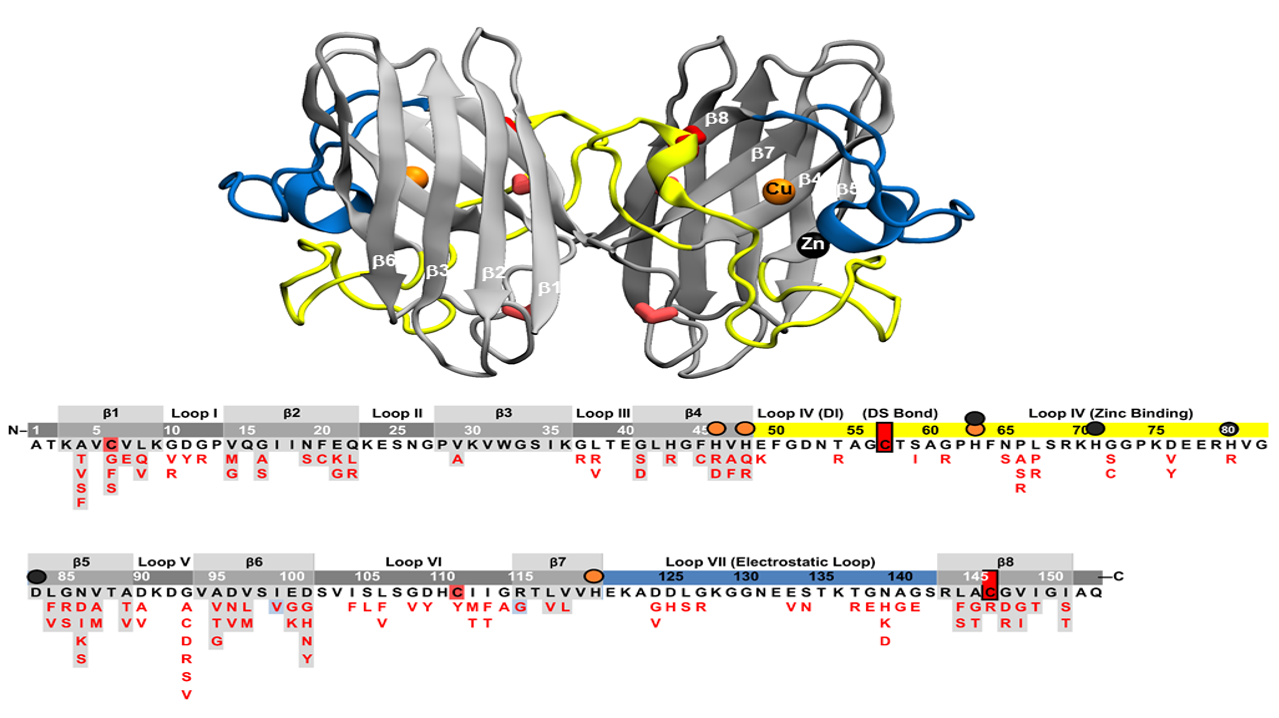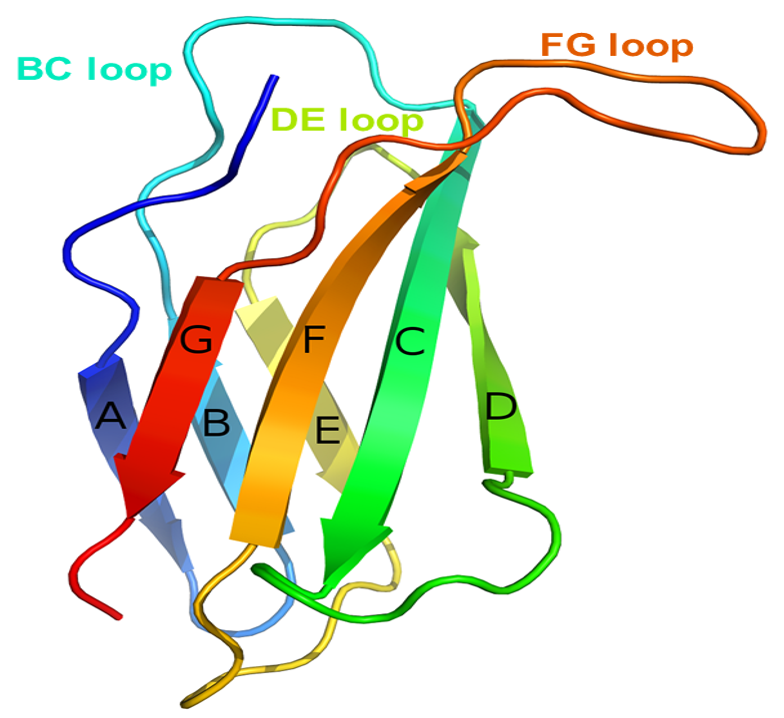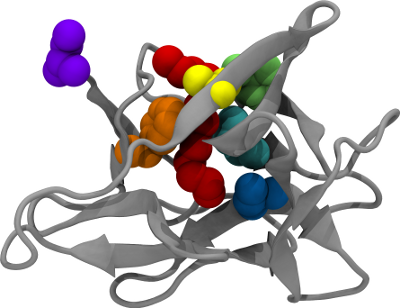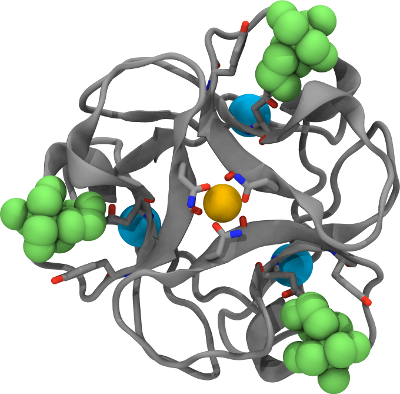We use a multidisciplinary collaborative approach combining a wide range of biophysical and biochemical experimental techniques with computational modelling to analyze and rationally alter diverse proteins. Current projects are described below.
SOD1 Adnectins Hisactophilin ThreeFoil
Superoxide dismutase (SOD1): Role of protein misfolding in disease

Amyotrophic Lateral Sclerosis (ALS) is a devastating and incurable neurodegenerative syndrome characterized by rapid degeneration of motor neurons. Mutations in the metalloenzyme, Cu,Zn-Superoxide Dismutase (SOD1) are associated with familial ALS cases, and a prominent disease hypothesis is that aggregation of mutant SOD1 is neurotoxic; however, the underlying mechanisms remain unclear. Furthermore, SOD1 undergoes various stabilizing post-translational modifications (metal binding, disulfide bond formation, and dimerization), and the forms of SOD1 most relevant to ALS toxicity are unknown.
Using a battery of biophysical and biochemical tools, we are measuring how mutations affect the stability, folding and aggregation of different forms of SOD1. Determining the roles of different forms of the SOD1 is critical for unraveling the molecular mechanisms underlying ALS and will help understand other common protein misfolding diseases such as Alzheimer's, Parkinson's, prions and cancer.
SOD1 is shown above in the native dimer form with ALS mutations highlighted in red.
- Schaefer, A., Naser, D., Siebeneichler, B., Tarasca, M.V., and Meiering, E.M.* Methodological advances and strategies for high resolution structure determination of cellular protein aggregates. J. Biol. Chem. (Online ahead of print). doi: 10.1016/j.jbc.2022.102197
- Naser, D., Tarasca, M.T., Siebeneichler, B., Schaefer, A., Deol, H.K., Soule, T.G.B., Almey, J., Kelso, S., Mishra, G.G., Simon, H., and Meiering, E.M.* High resolution NMR H/D exchange of human Cu,Zn superoxide dismutase inclusion bodies reveals significant native features despite structural heterogeneity. Angewandte Chemie International Edition 61e202112645 (2022). doi: 10.1002/anie.202112645
- Cveticanin, J., Monda, T., Meiering, E.M.*, Sharon, M.*, and Horovitz, A.* Insight into the autosomal-dominant inheritance pattern of SOD1-associated ALS from native mass spectrometry. J. Mol. Biol. 432, 5995-6002 (2020). doi: 10.1016/j.jmb.2020.09.025 Commentary
- Sekhar, A., Rumfeldt, J.A.O., Broom, H.R., Doyle, C.M., Sobering, R.E., Meiering, E.M. and Kay, L.E.* Probing the free energy landscape of ALS disease mutants of SOD1 by NMR spectroscopy. Proceedings of the National Academy of Sciences USA 113, E6939-45 (2016). (pdf)
- Doyle, C.M., Rumfeldt, J.A., Broom, H.R., Sekhar, A., Kay, L.E., and Meiering, E.M.* Concurrent increases and decreases in local stability and conformational heterogeneity in Cu,Zn superoxide dismutase variants revealed by temperature-dependence of amide chemical shifts. Biochemistry 55, 1346-1361 (2016). doi: 10.1021/acs.biochem.5b01133
- Broom, H.R., Rumfeldt, J.A., Vassall, K.A., and Meiering, E.M.* Destabilization of the dimer interface is a common consequence of diverse ALS-associated mutations in metal free SOD1. Protein Science 24, 2081-9 (2015). (pdf)
Adnectins: Stability and aggregation of engineered target binding proteins

Adnectins are an emerging class of protein therapeutics that can be engineered to address a broad range of diseases. They bind diverse medical targets with exquisite affinity and specificity via 3 antibody-like highly diversifiable binding loops.
Functional features in proteins, such as binding loops, often interfere with folding and can promote aggregation, including during therapeutic development and production using the most commonly used expression host, Escherichia coli. Using experimental and modelling methods, we are investigating the sequence determinants of Adnectin aggregation. The results are of wide interest for the design of "smart" libraries of new therapeutics.
A representative Adnectin structure is shown above with the ribbon coloured from blue to red (from N- to C- terminus) with beta-strands (A through G) and binding loops (BC, DE, FG) indicated.
- Trainor, K., Broom, A., and Meiering, E.M.* Exploring the relationships between protein sequence, structure and solubility. Current Opinion in Structural Biology 42, 136-146 (2017). doi: 10.1016/j.sbi.2017.01.004
- Trainor, K., Doyle, C.M., Metcalfe-Roach, A., Steckner, J., Lipovsek, D., Malakian, H., Langley, D., Krystek, S.R., and Meiering, E.M.* Design for solubility may reveal induction of amide hydrogen/deuterium exchange by protein self-association. J. Mol. Biol. 434 167398 (2022). doi: 10.1016/j.jmb.2021.167398
- Trainor, K., Gingras, Z., Shillingford, C., Malakian, H., Gosselin, M., Lipovsek, D., and Meiering, E.M.* Ensemble modeling and intracellular aggregation of an engineered immunoglobulin-like domain. J. Mol. Biol. 428, 1365-74 (2016). (pdf)
- Trainor, K., Palumbo, J.A., MacKenzie, D.W.S., and Meiering, E.M.* Temperature dependence of NMR chemical shifts: Tracking and statistical analysis. Protein Science 29, 306-314 (2020). doi: 10.1002/pro.3785.
Hisactophilin: Beta-trefoil protein with regulated pH-dependent function

We are investigating the molecular mechanisms controlling the stability, folding, myristoyl-switching and membrane- and actin-binding of hisactophilin using NMR spectroscopy, optical spectroscopies, chemical and thermal denaturation techniques and stopped-flow kinetics, in combination with atomistic and coarse-grained computational modeling.
Hisactophilin is a histidine-rich actin-binding protein involved in controlling cell shape and cytoskeletal stability. The structure of this protein is representative of the beta-trefoil superfold, a ubiquitous all-beta structure adopted by a great many natural proteins with highly diverse sequences and functions. Furthermore, hisactophilin is co-translationally modified by N-terminal myristoylation, which has a critical role in many cellular signalling processes such as pH-regulated membrane binding by hisactophilin where the myristoyl group reversibly switches between buried and membrane-accessible conformations.
Myristoylated hisactophilin is shown above, with the buried myristoyl group as red spheres and residues that modulate myristoyl switching shown as coloured spheres: F6 in orange, V36 in yellow, L76 in green, I85 in cyan, I93 in blue, and I118 in purple.
- MacKenzie, D.W.S., Schaefer, A., Steckner, J., Leo, C.A., Naser, D., Artikis, E., Broom, A., Ko, T., Shah, P., Ney, M.Q., Tran, E., Smith, M.T.J., Fuglestad, B., Wand, A.J., Brooks, C.L., and Meiering, E.M.* A fine balance of hydrophobic-electrostatic communication pathways in a pH- switching protein. Proceedings of the National Academy of Sciences USA 119e2119686119 (2022). doi: 10.1073/pnas.2119686119
- Shental-Bechor, D., Smith, M.T.J., Mackenzie, D., Broom, A., Marcovitz, A., Ghashut, F., Go, C., Bralha, F., Meiering, E.M.*, and Levy, Y.* Nonnative interactions regulate folding and switching of myristoylated protein. Proceedings of the National Academy of Sciences USA 109, 17839-44 (2012). (pdf)
- Smith, M.T.J., Meissner, J., Esmonde, S., Wong, H.J., and Meiering, E.M.* Energetics and mechanisms of folding and flipping the myristoyl switch in the beta-trefoil protein, hisactophilin. Proceedings of the National Academy of Sciences USA 107, 20952-20957 (2010). (pdf)
Engineering protein folding and function: ThreeFoil, a superstable, symmetric, carbohydrate-binding beta-trefoil

A protein superfold is a common structure adopted by numerous proteins with diverse primary sequences and functions. Previous studies suggest the beta-trefoil superfold arises from the repetition of a single subdomain unit (one-third of a beta-trefoil). To explore the validity of this model we reconstructed the perfectly symmetrical ThreeFoil, using bioinformatics and computational modelling methods.
ThreeFoil has remarkably high structural symmetry, very high thermal stability (melting temperature of ~95 degrees Celsius), unfolds extremely slowly (unfolding half-life of ~8 years), and binds multivalent carbohydrates with high affinity and specificity. We are further investigating the rational design of stability, solubility and carbohydrate binding function, which have broad applicability to other proteins.
ThreeFoil is shown above with its symmetric carbohydrate ligands as light green spheres (with coordinating sidechains as sticks), structurally conserved buried water molecules in light blue, and a metal ion that binds along the axis of symmetry in yellow (with coordinating protein sidechains as sticks).
- Broom, A., Trainor, K., MacKenzie, D.W.S and Meiering, E.M.* Using natural sequences and modularity to design common and novel protein topologies. Curr. Op. Struct. Biol. 38, 26-36 (2016). doi: 10.1016/j.sbi.2016.05.007
- Broom, A., Jacobi, Z., Trainor, K., and Meiering, E.M.* Computational tools help improve protein stability but with a solubility tradeoff. Journal of Biological Chemistry 292, 14349-61 (2017). Protein Stability Meta-Predictor
- Broom, A., Trainor, K., Jacobi, Z., and Meiering, E.M.* Computational modelling of protein stability: quantitative analysis reveals solutions to pervasive problems. Structure 28, 717-726 (2020). doi: 10.1016/j.str.2020.04.003
- Broom, A., Ma, S.M., Xia, K., Rafalia, H., Trainor, K., Colon, W., Gosavi, S., and Meiering, E.M.* Designed protein reveals structural determinants of extreme kinetic stability. Proceedings of the National Academy of Sciences USA 112, 14605-10 (2015). (pdf)
- Broom, A., Doxey, A.C., Lobsanov, Y.D., Berthin, L.G., Rose, D.R., Howell, P.L., McConkey, B.J.*, and Meiering, E.M.* Modular Evolution and the origins of symmetry: Reconstruction of a three-fold symmetric globular protein. Structure 20, 161-171 (2012). (pdf)
Collaborators
We collaborate with research groups, across Canada and internationally, in academia and industry, that have complementary research expertise to our own. See current collaborators.
Funding





